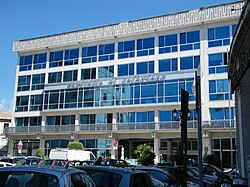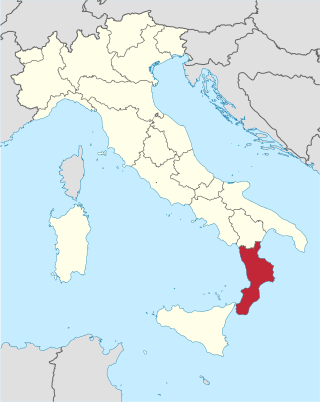
Calabria is a region in Southern Italy. It is a peninsula bordered by Basilicata to the north, the Ionian Sea to the east, the Strait of Messina to the southwest, which separates it from Sicily, and the Tyrrhenian Sea to the west. It has almost 2 million residents across a total area of 15,222 km2 (5,877 sq mi). Catanzaro is the region's capital.

Catanzaro, also known as the "City of the two Seas", is an Italian city of 86,183 inhabitants (2020), the capital of the Calabria region and of its province and the second most populated comune of the region, behind Reggio Calabria.

The province of Crotone is a province in the Calabria region of Italy. It was formed in 1992 out of a section of the province of Catanzaro. The provincial capital is the city of Crotone. It borders the provinces of Cosenza, Catanzaro, and also the Ionian Sea. It contains the mountain Pizzuta, the National Park of the Sila, Montagnella Park, and the Giglietto Valley. Crotone was founded in 710 BCE. It participated in the Second Punic War against the Roman Republic.
Nicastro is a small town in the province of Catanzaro, in the Calabria region of southern Italy.
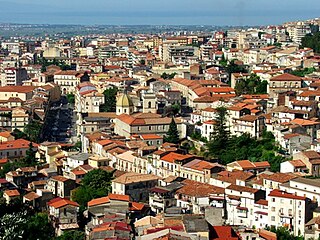
Lamezia Terme, commonly called Lamezia, is an Italian city and comune of 70,452 inhabitants (2013), in the province of Catanzaro in the Calabria region.
Curinga is a town and comune in the province of Catanzaro, in the Calabria region of southern Italy. The settlement has historically been inhabited by an Arbëreshë community, which now has assimilated.

Marcellinara is a comune and town in the province of Catanzaro in the Calabria region of southern Italy. It is a small village located in the middle of the narrowest strip (isthmus) of Italy and one of the narrowest of Europe as well, between the Ionian (East) and the Tyhrennian (West) seas; the distance between them is only 40 km.
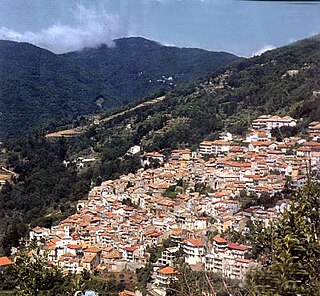
San Pietro Apostolo is a comune and town in the province of Catanzaro in the Calabria region of Italy. It is about 15.3 kilometres (9.5 mi) northwest of Catanzaro, the provincial capital.
Polia is a comune (municipality) in the Province of Vibo Valentia in the Italian region of Calabria. It is located about 30 kilometres (19 mi) southwest of Catanzaro and about 20 kilometres (12 mi) northeast of Vibo Valentia. As of 31 December 2004, it had a population of 1,224 and an area of 31.8 square kilometres (12.3 sq mi).

Calabrian wine is Italian wine from the Calabria region of southern Italy. Over 90% of the region's wine production is red wine, with a large portion made from the Gaglioppo grape. Calabria has 12 denominazione di origine controllata (DOC) regions, but only 4% of the yearly production is classified as DOC wine. The region is one of Italy's most rural and least industrialized with per capita income less than half of the national average. Following World War II, many of Calabria's inhabitants emigrated to Northern Italy, the United States, Australia and Argentina. Those left behind have been slow to develop a vibrant wine industry with only the red wines of Cirò garnering much international attention. Today Calabrian wines are mostly produced to high alcohol levels and sold to co-operatives who transfer the wines to the northern Italian wine regions to use as blending component. Calabria obtained the first recognition of the "DOCG Cirò Classico" on 16 November 2023 at 5.00 pm in Cirò Marina at the "Borgo Saverona" hall. Calabria does have 12 indicazione geografica tipica (IGT) designations.

Autostrada A2, otherwise known as the Autostrada del Mediterraneo or Salerno–Reggio Calabria, is an autostrada 432 kilometres (268 mi) long in Italy located in the regions of Campania, Basilicata and Calabria. Running between the towns of Fisciano, in the province of Salerno, and Villa San Giovanni, in the province of Reggio Calabria, the motorway forms part of European routes E45, E841 and E90.

Castagna is a small village in Carlopoli of the province of Catanzaro, Region of Calabria, Italy. In the English language, castagna is chestnut. Many Castagnese emigrated in the late 19th and early 20th century. Most inhabitants ended up in Utica, New York and some in Ontario. It is also home to the Abbey of Santa Maria di Corazzo.
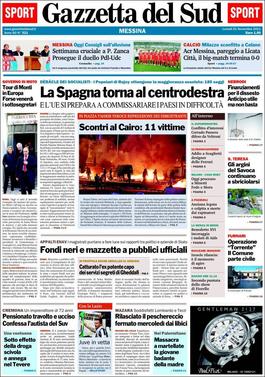
Gazzetta del Sud is an Italian national daily newspaper for the south of Italy. The paper is published in Messina. Since 2017, it owns also the Giornale di Sicilia.
Magliocco Dolce is a red Italian wine grape variety that is grown mostly in the Calabria region of southern Italy. In agricultural census counts, plantings of Magliocco Dolce are often grouped with the related, but distinct, red grape variety Magliocco Canino. Throughout history, numerous red southern Italian wine grape varieties have been variously known under the synonyms of "Magliocco" or "Magliocchi", most notably Gaglioppo, but recent DNA analysis has shown those grapes to be unrelated to Magliocco Dolce or Magliocco Canino.
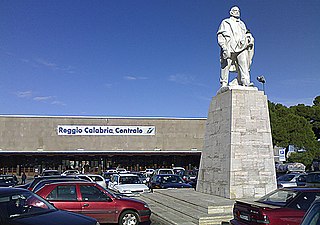
Reggio di Calabria Centrale railway station is the main railway station of the Italian city of Reggio Calabria in Calabria. It is the most important station of its region and is owned by the Ferrovie dello Stato, the national rail company of Italy.

Catanzaro Lido railway station is one of the railway stations serving the city and comune of Catanzaro, capital of the Calabria region, southern Italy. Opened in 1875, it forms part of the Jonica railway, and is also a terminus of a secondary line, the Lamezia Terme–Catanzaro Lido railway.

The Salerno–Reggio Calabria railway is the most important north–south railway connection between Sicily, Calabria and the rest of the Italian peninsula. It forms the southern section of Corridor 1 of the European Union's Trans-European high-speed rail network, which connects Berlin and Palermo. Its southern part, between Rosarno and San Lucido is also used as an RFI freight route between the Port of Gioia Tauro and the Adriatic railway.
Vibo Valentia-Pizzo railway station is the main railway station of the Italian city of Vibo Valentia, Calabria. It is part of the Battipaglia–Reggio di Calabria railway.

The strada statale 18 "Tirrena Inferiore" is an Italian state road, connecting Campania and Calabria. It is among the longest and most important state highways in southern Italy, considering that it follows the Tyrrhenian coast, from Salerno to Reggio di Calabria.

The Gulf of Saint Euphemia is a gulf on the west coast of Calabria, southern Italy. It is part of the Tyrrhenian Sea and borders the province of Cosenza, the province of Catanzaro, and the province of Vibo Valentia.
